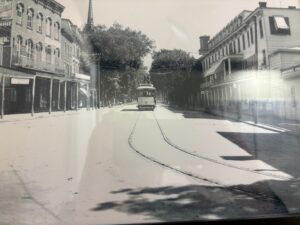
Type the official name Town of Cortlandt into Google Maps and a red-dot marker points to a random house on Mountain Side Trail. Searches for Cortlandt Manor zero in on a Sassinoro Boulevard home. This contrasts with the results for surrounding towns, whose borders are delineated by a bold red outline.
Cortlandt, a 34.5 square mile expanse that remained mostly rural through the 1960s, lacks an organic downtown. Overshadowed by Peekskill and its prime riverfront location, the surrounding municipality has long suffered from a mild identity crisis.
Tucked into the remote and rugged northwestern corner of the county, Cortlandt shares the same rich history as the rest of Westchester, a past etched onto the present by geography and place names.
Senasqua, which delineates a park and road in the Cortlandt village of Croton-on-Hudson, is the Native American name for a marsh on Croton Point. Meahagh, which predated the term Verplanck, is now attached to that hamlet’s human-created Lake Meahagh.
Cortlandt, Van Wyck and Verplanck resurrect the old Dutch presence. Furnace Woods and Foundry Brook refer to the iron smelting operations that established local industry in the early 1800s.

In 1788, the State of New York formally abolished the Dutch patroon system of landholding and carved Westchester into 20 towns. An informal subdivision of Cortlandt into 17 districts placed the names of tiny hamlets and enclaves onto maps and into consciousness, diluting the town’s central pull.
Many are still recognizable: Buchanan, Crugers, Montrose, Oregon Corners, Van Cortlandtville. Others, like Annsville, Toddville and Pleasantside, are more obscure. Some became Post Office designations, which amplified localized identities.
The town’s first jail and municipal building stood at 7th Street and Broadway in Verplanck and eventually moved to Peekskill. A falling out in the 1930s led the Village of Peekskill to adopt a City Charter in 1940.
Most government offices relocated to the Croton-on-Hudson Municipal Building and, in 1992, Cortlandt’s current Town Hall opened in a refurbished elementary school.
Another hindrance to forging a town-wide identity centered on U. S. Postal Service policy. The oldest Post Office, Verplanck, dates to 1838. Buchanan, Crugers, Montrose and Croton-on-Hudson followed. The rest of Cortlandt’s mail always routed through Peekskill.
But postal officials contended that the name Cortlandt created too much confusion with the upstate city of Cortland and banned its use. They required that mail to the unincorporated parts of town be addressed to Peekskill and use zip code 10566. Many letters running afoul of the rules got returned to sender.
In 1991, after former Town Supervisor Jack Gaffney rallied residents and brainstormed new names, the feds eventually agreed to accept mail addressed to Cortlandt Manor, which refers to the manors of Stephanus Van Cortlandt, a pivotal local figure during the colonial era.
Located across the street from Town Hall, on Oregon Road, the northern manor is now an elaborate storage space for Cortlandt Healthcare. The family’s other local home is the Van Cortlandt Manor house museum in Croton. In the early 2000s, the town got its own ZIP code, 10567, creating more cohesion.
The most impactful long-term changes centered on transportation innovations and the infrastructure to accommodate them. The King’s Highway, also known as Albany Post Road (9A), dates to 1723 and passed through what is now downtown Peekskill.
The railroad reached the area in 1849, but the automobile made the greatest impact, said local historian Frank Goderre. The Bear Mountain Bridge, which turns 100 this year, he said, “completely transformed Cortlandt and Westchester as the first vehicular Hudson River crossing between New York City and Albany.”
Then came the Taconic Parkway and the countywide river valley roadway system, including the Saw Mill River and Hutchinson River parkways. The Bear Mountain Parkway and the Briarcliff-Peekskill Parkway date to the 1930s.
The advent of interstate highways in the 1950s also helped suburbanize Cortlandt. Completed in 1967, Route 9 from Croton to Peekskill is the only built section of the cancelled Hudson River Expressway (I-487), which would have stretched from The Bronx (I-87) to Beacon (I-84). Between 1950 and 1970, Cortlandt’s population surged from 14,146 to 34,393.
“Before they built the [Bear Mountain] bridge, there was nothing here, not even a road to get to the site of the current crossing,” said Goderre. “Except for Peekskill, it was all farms, a few estates and empty land.”







Yes but never let it be said that Aaron Copland’s House is in Cortlandt Manor. It was originally built on acreage belonging to the city of Peekskill, zip code 10566, and so shall it ever remain. That goes for Jackie Gleason’s House as well. I think it was a real mistake to settle a post office dispute this way and cannot understand how something of that magnitude ever got passed.
I learned so much from this article.
Cool! Thank you!
Excellent information about our town